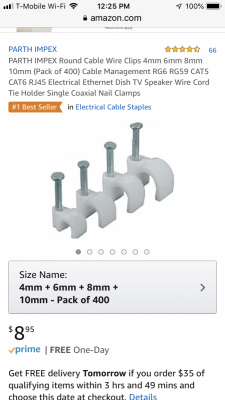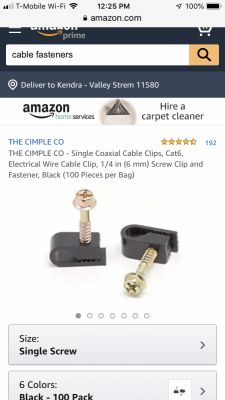Navigation
Install the app
How to install the app on iOS
Follow along with the video below to see how to install our site as a web app on your home screen.
Note: This feature may not be available in some browsers.
More options
You are using an out of date browser. It may not display this or other websites correctly.
You should upgrade or use an alternative browser.
You should upgrade or use an alternative browser.
Installing RO Faucet in sink
- Thread starter BlueWorldJeff
- Start date
- Tagged users None
- Joined
- Nov 16, 2016
- Messages
- 216
- Reaction score
- 95
I ran the RO tubing through the back of my cabinets to get from filter to sink, what it the best and cleanest way to attach the 1/4" tubing to the back wall of the cabinet?
Loop so no odors and contamination back to dw.Just connect the dishwasher drain directly to disposal with an upward loop. No air gap valve, no 7/8 hose.
- Joined
- Oct 1, 2017
- Messages
- 3,128
- Reaction score
- 2,592
Is there a coupler or adapter that is sold that can replace the air gap and I can mount it up high for the same effect? Is it 5/8" dish washer drain and 7/8" to the disposal?
Dishwasher drain hoses have step down sizes on end. Push it onto first size and it’s 7/8. Push it on further and it’s 5/8. Unless they cut it off.
If you position drain hose with an upside down loop, as I pictured in an above post, that is an air gap. When the drain comes on the hose is filled with water. Drain Shute off and water runs down leaving air in its place, hence “air gap”
- Joined
- Oct 1, 2017
- Messages
- 3,128
- Reaction score
- 2,592
Loop for odor is on sink drain, known as a trap. The trap remains filled with water, even when not in use, trapping the gasses inside pipe. That is the opposite of an air gapLoop so no odors back to dw.
Correct, that why I didn't mention sewer gases. But without loop will get smells from some foods, cantaloupe exampleLoop for odor is on sink drain, known as a trap. The trap remains filled with water, even when not in use, trapping the gasses inside pipe. That is the opposite of an air gap
use these to secure the tubing: https://www.buckeyehydro.com/tubing-clamp-nylon-5-pack/
- Joined
- Oct 1, 2017
- Messages
- 3,128
- Reaction score
- 2,592
Not really understanding what you’re saying. The upside down loop works the same way the air gap valve does. A trap is the opposite and is immediately downstream of the air gap. An air gap, whether valve or loop, does not stop gasses from escaping. It keeps head pressure off pump at startup, and breaks the siphon.Correct, that why I didn't mention sewer gases. But without loop will get smells from some foods, cantaloupe example
Dishwasher drain hoses have step down sizes on end. Push it onto first size and it’s 7/8. Push it on further and it’s 5/8. Unless they cut it off.
If you position drain hose with an upside down loop, as I pictured in an above post, that is an air gap. When the drain comes on the hose is filled with water. Drain Shute off and water runs down leaving air in its place, hence “air gap”
I'll respectfully disagree. If I'm understanding you correctly, this is not an air gap.
Russ
- Joined
- Oct 1, 2017
- Messages
- 3,128
- Reaction score
- 2,592
Upside down loop makes an air gap. It is not an air gap valve. Does the same thing, and is one less thing that can clog.I'll respectfully disagree. If I'm understanding you correctly, this is not an air gap.
Russ
The purpose of an air gap in this instance is to create a situation where a backup in the plumbing CANNOT find its way into the concentrate tube and then back to the membrane. The upside down loop does not do this. The top of the loop would need to extend above the maximum water level in the sink for the loop to work. In your video it is below that level by the thickness of the counter.
Russ
Russ
Last edited:
- Joined
- Oct 1, 2017
- Messages
- 3,128
- Reaction score
- 2,592
Membrane?
Air gap valve does the same thing. Except it can leak onto countertop if the drain hose becomes clogged. Some would say that’s to alarm you of a clog. I say it’s a big smelly mess on your counter, instead of inside your dishwasher
Either way, air gap valve or loop, they do not stop gasses from escaping. That’s what the trap does
Air gap valve does the same thing. Except it can leak onto countertop if the drain hose becomes clogged. Some would say that’s to alarm you of a clog. I say it’s a big smelly mess on your counter, instead of inside your dishwasher
Either way, air gap valve or loop, they do not stop gasses from escaping. That’s what the trap does
- Joined
- Oct 1, 2017
- Messages
- 3,128
- Reaction score
- 2,592
The waste line from ro should go to drain but above trap so it falls into air in drain. Another words, the end of ro waste line is discharging into the air, above waterline, so no siphon or flow goes back to ro unit is possible. Not to mention, any decent ro unit has a one way check valve, which prevents this as well
That is true, unless water backs up to a level above the drain saddle. Most RO systems are built without a check valve on the concentrate line. A check valve would not be an appropriate way to deal with back up in the concentrate line. In many locations, an air gap is required (by code) on the concentrate line of an RO. They are often built in to the faucet: https://www.buckeyehydro.com/faucets-1/
- Joined
- Nov 16, 2016
- Messages
- 216
- Reaction score
- 95
I have my RODI filter in the laundry room with the waste line going down the washer drain. So no problems there
- Joined
- Oct 1, 2017
- Messages
- 3,128
- Reaction score
- 2,592
The sink would have to be close to overflowing for the air gap valve to have an advantage in height.That is true, unless water backs up to a level above the drain saddle. Most RO systems are built without a check valve on the concentrate line. A check valve would not be an appropriate way to deal with back up in the concentrate line. In many locations, an air gap is required (by code) on the concentrate line of an RO. They are often built in to the faucet: https://www.buckeyehydro.com/faucets-1/
You May be right but I have never seen an ro unit tap/faucet have a built in air gap. Nor does the one in link. Ro check valve is on the product line coming out of membrane, and with a hi/low switch that shuts off waste, and water coming into unit, a check valve there is a perfectly acceptable way of preventing back flow. Even if you don’t see it, on the product line out of the membrane there is likely a check valve on your ro unit
Look at the faucets at the link I provided - there's an air gap version as well as a non air gap version there.
Thanks for the pointers . I've built and sold and maintained and repaired thousands of residential and commercial RO systems over the last 20+ years. I've taught seminars on their configuration and function. I'm pretty familiar with their proper configuration. I'm ok with you having a different opinion on the topic
. I've built and sold and maintained and repaired thousands of residential and commercial RO systems over the last 20+ years. I've taught seminars on their configuration and function. I'm pretty familiar with their proper configuration. I'm ok with you having a different opinion on the topic  .
.
Thanks for the pointers
Similar threads
- Replies
- 5
- Views
- 309
- Replies
- 1
- Views
- 160
- Replies
- 3
- Views
- 193






















